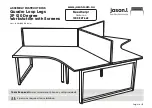
53
Peavey PC1600X User Manual (rev-h)
UGH…
Why go to this much trouble?
a.
We love confusion
b.
We’re techno wiz bangs
c.
We’re rocket scientists
d.
It’s the best Way
Take a byte
Actually, it really is the best way. When a byte is “sliced” in half (two nibbles) a maximum of 16 values (per
nibble) are possible. This obviously translates well into a hex number. An eight-bit number, therefore,
easily translates into TWO hex digits.
Since eight-bit binary numbers are referred to as a byte, the two-digit hex representation is also called a byte.
A nibble translates nicely into one hex value. Just “cut” the byte into two nibbles, then assign a hex value to
each. You end up with hex numbers like these:
Note: h signifies hexadecimal number)
Those Familiar Hex Numbers
You’ve probably noticed many decimal numbers used by synthesizers that reveal hexadecimal “activity.”
All the way from present numbering systems to polyphony, these hex numbers “pop up” in a variety of
places.
Now, we have a basic understanding of hex numbers, so what do we do with them?
Hexadecimal messages create a variety of different types of MIDI messages. This gives you the ability to
“talk” to your synthesizer directly. Check out the MIDI 101 article for specific hex messages that you can
use. Also, next month, we’ll be looking at Status, and Data bytes. Don’t miss it!
Summary of Contents for PC1600X
Page 1: ...1 Peavey PC1600X User Manual rev h Peavey PC1600X ...
Page 2: ...2 Peavey PC1600X User Manual rev h ...
Page 11: ...11 Peavey PC1600X User Manual rev h ...
Page 13: ...13 Peavey PC1600X User Manual rev h ...
Page 57: ...57 Peavey PC1600X User Manual rev h ...
Page 58: ...58 Peavey PC1600X User Manual rev h ...
Page 59: ...59 Peavey PC1600X User Manual rev h ...
Page 60: ...60 Peavey PC1600X User Manual rev h ...
Page 61: ...61 Peavey PC1600X User Manual rev h ...
Page 62: ...62 Peavey PC1600X User Manual rev h ...
Page 63: ...63 Peavey PC1600X User Manual rev h ...
Page 64: ...64 Peavey PC1600X User Manual rev h ...














































